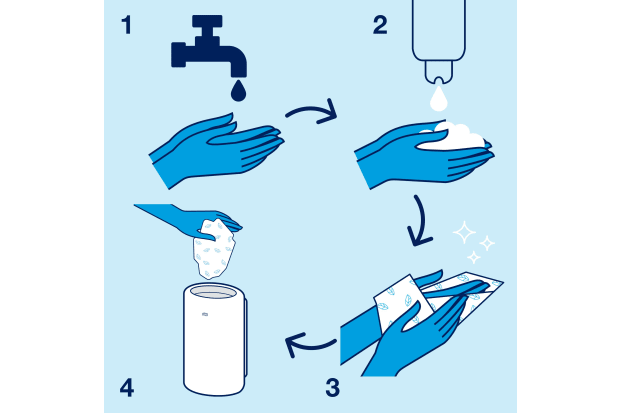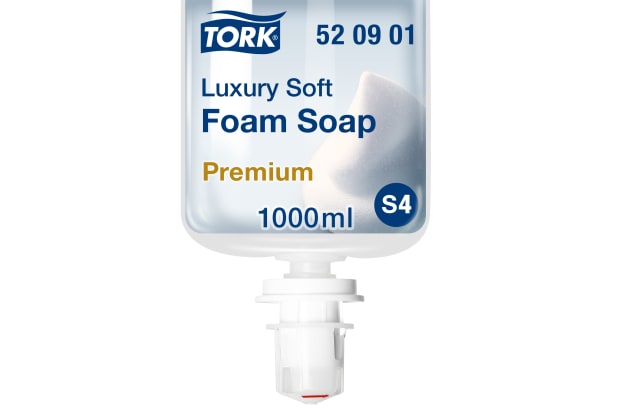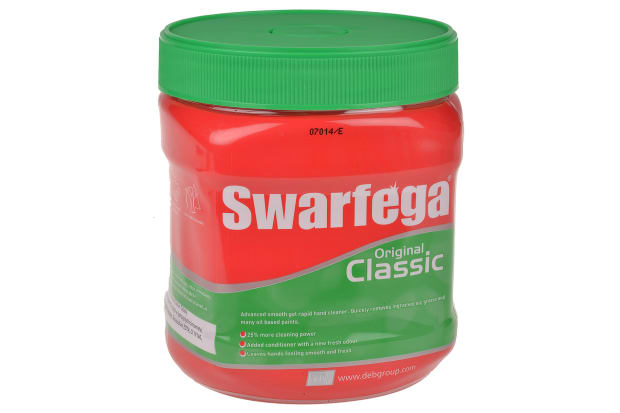- Published 5 Jan 2023
- Last Modified 4 Sept 2023
- 11 min
Everything You Need To Know About Hand Cleaners & Soaps

What are hand cleaners and soaps?
Hand cleaners and soaps come in a wide variety of formulations, designed for use in many different demanding workplace environments.
Hand soap can either be hard - as in traditional bar soap - soft, or entirely liquid in form. In most cases, the hardness of a soap is dictated by whether or not hardening agents have been added to the base mix (this is why many 100% natural bar soaps tend to feel softer and deplete more quickly).
Whatever the precise make-up of the hand cleaner you’re using, their basic functions and properties are likely to be very similar across the board (with the exception of some specialist formulas):
- The vast majority of bar soaps are essentially a mixture of animal or vegetable fats and oils. These are combined with a strong alkali solution, and often some type of perfume or fragrance. If moisturisers are not added, most soaps of this kind will tend to be somewhat drying to many skin types due to their pH levels.
- Liquid cleaners and detergents tend to be petroleum-based, incorporating emulsifying and stabilising agents to give them their familiar silky smooth consistency. In addition, many leading brands from industrial hand soap manufacturers often boost their effectiveness with added antibacterial solutions, degreasing solvents or mild abrasives. Liquid hand soaps are also easy to blend with other ingredients, such as moisturisers, to achieve a non-drying and pH-balanced formula.
All soaps and liquid hand cleaners are ultimately designed to make it easier to remove grease, bacteria and other contaminants from the skin. The active ingredients in industrial hand soaps help to dissolve and dilute stubborn dirt, allowing it to mix more readily with water before being scrubbed off and rinsed away.
When and how to wash your hands

Proper hand washing technique is absolutely key to ensuring your hand soap performs as effectively as possible. It’s also vital to make sure you’re washing your hands often enough to minimise the risk of cross-contamination from dirt, bacteria and other contaminants.
There are certain times you should ALWAYS wash your hands at home or in the workplace, including:
- Before, during and after preparing food
- Before eating food
- After using the toilet
- After helping anyone else use bathroom facilities (e.g. changing a baby)
- After handling refuse
- After contact with animals, animal feed or animal waste (whether domesticated or not)
- Regularly whenever you (or someone you’re in direct physical contact with) is unwell
- Any time you cough, sneeze or blow your nose
- Before and after treating wounds
Even if you’re washing your hands at all the appropriate times, poor hand washing technique can lead to higher risk of cross-contamination, allowing the transfer of germs and bacteria between multiple sources and people. The most common mistakes people tend to make when cleaning their hands are:
- Not washing hands thoroughly with soap
- Allowing insufficient hand washing time
- Forgetting to wash nails, wrists, backs of hands, or between fingers
- Using unsuitable drying techniques or materials
- Touching unwashed surfaces, fixtures or fittings during or immediately after cleaning hands
With these common oversights in mind, the following technique outlines the ideal way to wash your hands for optimal cleaning and hygiene:
- Wet hands with warm, clean, running water
- Apply a sensible quantity of soap - usually one pump of the dispenser, if it’s liquid soap - and rub into a rich lather without diluting further
- Spend at least 20 seconds rubbing the soap around all areas of the hands, including:
- across both palms
- along the full length of your fingers and thumbs
- around cuticles and under the nails
- in between fingers, by interlocking them (in both palm-to-palm and palm-to-back-of-hand positions) and rubbing back and forth
- around the full length of both thumbs, by rotating them in your palms
- over the heels of your hands and slightly up the wrists, both front and back
- Rinse carefully with warm, clean, running water, making sure to remove all of the soap - it’s during this phase that the soap will take dirt, grease and bacteria with it as it’s washed off
- Dry hands as thoroughly as you can with either an air blower or, better still, disposable towels (ideally recycled). If a disposable towel is available, also use it to turn off the tap. Be mindful of minimising skin contact, to whatever extent is practical, with other washing area fittings and fixtures as you leave

Note:
Never use your clothing or washable towels, such as tea towels, to dry your hands after cleaning them. This is especially important in public areas, food service industries or otherwise higher-risk environments, for example at medical hand washing stations. Reusable cloth towels left in these areas can often carry just as much - if not more - bacteria as entirely unwashed hands!
Liquid Soap
For many of the reasons outlined above, liquid hand cleaner is usually a more suitable option than traditional bar soap in most busy, high turnover areas and fast-paced workplaces. Many people prefer to use liquid soap at all times, whether it’s in offices, workshops or at home, due to its all-round convenience and skin-friendly formulas.
Bar soaps become fiddly to use once they start to wear down, becoming gradually more hardened and slippery, and eventually leading to increased waste as slivers are often dropped, lost or thrown out before they’re finished. Hard soaps tend to leave a lot of scum and residue behind after successive uses, which can look unsightly over time if not washed away regularly. Most people also prefer to eliminate any perceived risk of cross-contamination that comes from sharing a bar soap with other users.
By contrast, liquid soap can be dispensed quickly and conveniently from a handy one-touch dispenser and leaves little or no mess behind. Although scientific testing hasn’t shown bar soaps to transfer problematic levels of bacteria between users, liquid soaps are still widely seen as the more hygienic option overall by many people in high-turnover workplaces and environments.
As previously noted, liquid hand cleaners are very often boosted by the addition of degreasing solvents, antibacterial agents or mild abrasives, making them more effective at powerfully removing stubborn or ingrained dirt.
True liquid ‘soap’ is actually fairly uncommon, as it’s relatively difficult to produce - most wholesale liquid hand soaps are technically variant forms of detergent. The detergent element in liquid hand soap blends is also called a surfactant, and it’s this essential ingredient that breaks down stubborn dirt or grease.
During scrubbing and rinsing, the surfactant helps dilute and dissolve contaminants or bacteria on the skin, making for much easier and more efficient removal than would be possible with water alone.
Liquid hand washing products are generally less skin-drying than traditional bar soaps, too. It’s easy to incorporate moisturisers and other protective additives into a liquid soap formula, meaning they don’t tend to dry, crack or irritate the hands even after prolonged and repeated use.
Liquid soap usually produces a far richer lather and feels nicer on the skin than hard soap, which in turn encourages users to wash for longer and therefore remove bacteria or contaminants more effectively.
Industrial Hand Cleaner
Industrial hand soap can be formulated for extra effectiveness on a wide range of tougher or more stubborn dirt types.
In garages and workshops, hand cleaner might be needed that tackles grease and oil better than standard soaps. In factory or production environments, it might be necessary to introduce liquid soaps that are highly effective against cross-contamination, with strong antibacterial properties. If employees are likely to be washing their hands very often, it might be ideal to opt for an industrial hand soap that also has protective qualities for healthier skin.
When looking to buy industrial hand soap wholesale, there are several important things to bear in mind. These include:
- the sorts of tasks users will be performing, and the potential sources of grease, bacteria and other contaminants they’ll come into contact with
- the type of formula you’re therefore likely to need in a hand cleaner for your specific work environment
- how busy a washroom area you’re going to need to cater to during a typical working week, and whether it will be more cost-effective to buy hand soap in large capacity containers
You should also consider whether you’re likely to benefit from a fragranced industrial hand soap formula, or a more neutral unfragranced variety.
In many industrial and workplace settings, it’s often advantageous to pair your choice of liquid hand wash with a hand sanitiser. These are a distinct category of hand cleaning product from soaps themselves, but they achieve similar goals in many ways. In the section below, we’ll address the precise differences between the two.
Difference between hand soap and hand sanitiser
Whereas hand soap is designed to work with water to break down and dilute dirt, grease and bacteria - thus making it easier to remove from skin - hand sanitiser is a water-free hand-cleaning product usually dispensed as an alcohol-based gel or foam.
Hand sanitiser gels and foams are commonly found in hospitals, surgeries, care facilities and other medical environments, where it’s crucial to limit the transfer of germs and bacteria from one location to another around the workspace. For this reason, they’re also an excellent addition to food service businesses and premises, as well as to any busy public washroom or toilet facilities.
Sanitiser products are not intended as an alternative to washing, or as a ‘speedy’ replacement. They are designed either to offer an additional level of cleansing in settings where it’s important to achieve a higher standard of cleanliness or as a next-best option in areas where regular thorough washing with soap and water is impractical or unavailable.
For optimal effectiveness, a hand sanitiser foam or gel should contain alcohol (usually ethanol) at a concentration higher than 50%. At higher strengths, this quickly kills or neutralises a wide range of bacteria and pathogens - although it’s important to note that it won’t necessarily rid skin of ALL such contaminants, especially if not coupled with thorough and regular washing.
Hand sanitisers are typically applied in a very similar fashion to liquid soaps. Users should dispense a suitable amount - usually around half a teaspoon, but check the label to confirm this - onto the palm of one hand.
Then proceed to rub and scrub the gel or foam carefully around all the same areas of the hands, fingers, nails and wrists we described above. Again, this should be done over the course of about 20 seconds; if you’ve used the correct amount of sanitiser, that’s roughly how long it should take to dry fully on the skin.
Summary
Whether you require an industrial hand soap supplier for a workshop or garage, an office washroom, a public toilet facility, a restaurant kitchen and food service area, or even for high-volume use around the home, it’s important to familiarise yourself with the types and brands available.
Knowing exactly what each sort of these incredibly useful and effective products does (and doesn’t do!) will help you pick out the right formula for your needs. Once you’ve made your choice, combining effective and thorough hand washing techniques with additional products such as sanitising gels and foams will ensure your workplace or home stays clean and hygienic for all users, no matter how busy, dirty or challenging the environment.
Feel free to contact our expert customer care team if you have any further questions about hand wash pricing, wholesale options, or which of our many industrial hand wash brands and solutions might be best for you.
Product spotlights
With so many different types of Hand Cleaners available, it can be hard to know which one to choose. Here are some of the most popular brands of Hand Cleaners we offer. Click through to view the full product range:
Related links
- Soap & Hand Cleaners
- SCJ Professional Floral Azure FOAM Hand Soap - 1L Cartridge
- SCJ Professional Citrus Solopol® Lime Hand Soap - 4L Cartridge
- SCJ Professional Unscented Estesol® PURE Hand Soap - 2L Cartridge
- SCJ Professional Unscented Estesol® PURE Hand Soap - 4L Cartridge
- SCJ Professional Citrus Solopol® Lime Hand Soap - 2L Cartridge
- SCJ Professional Citrus Citrus Power Wash Hand Soap - 2 L Cartridge
- SCJ Professional Citrus Citrus Power Wash Hand Soap - 4 L Cartridge


